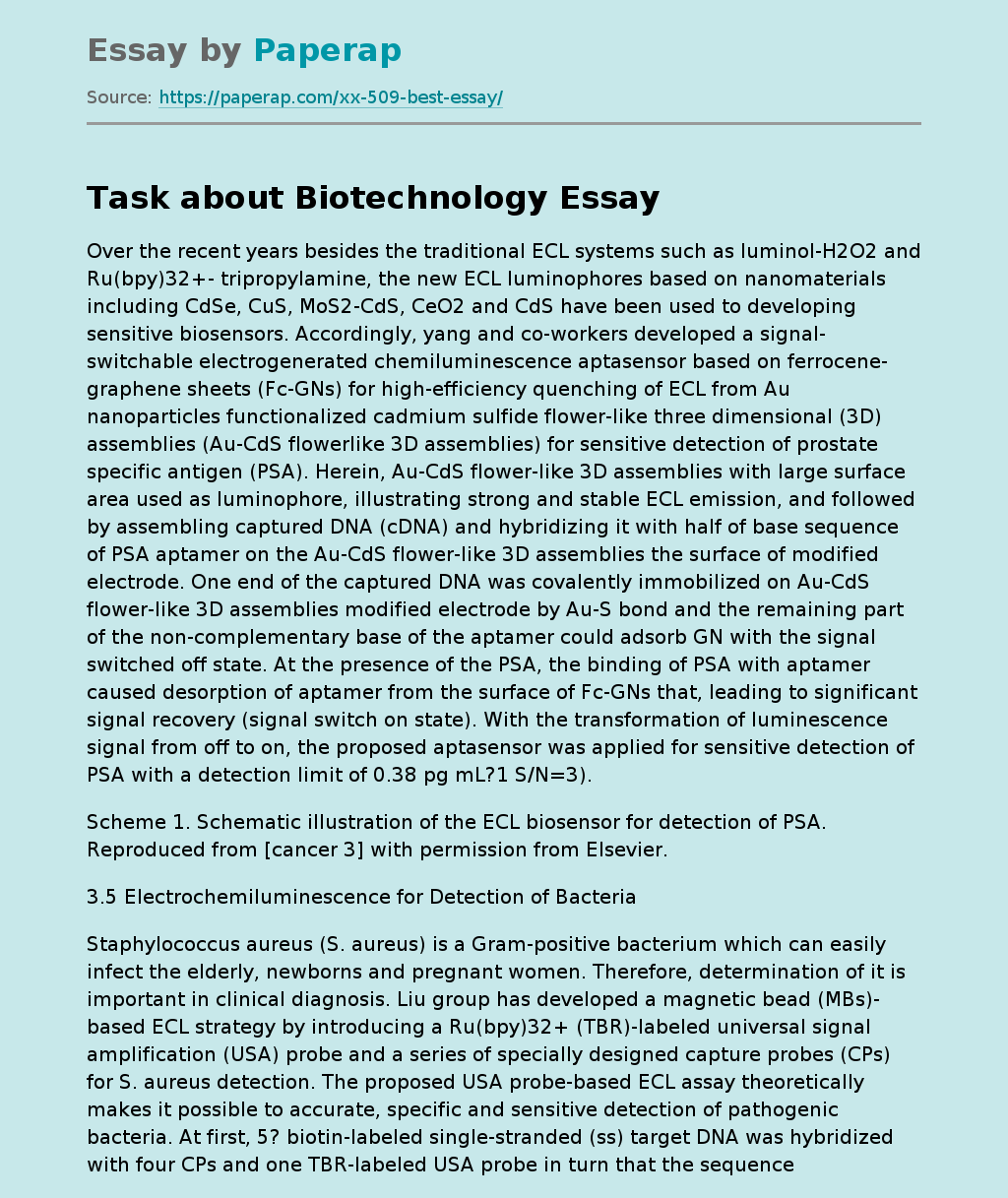Over the recent years besides the traditional ECL systems such as luminol-H2O2 and Ru(bpy)32+- tripropylamine, the new ECL luminophores based on nanomaterials including CdSe, CuS, MoS2-CdS, CeO2 and CdS have been used to developing sensitive biosensors. Accordingly, yang and co-workers developed a signal-switchable electrogenerated chemiluminescence aptasensor based on ferrocene-graphene sheets (Fc-GNs) for high-efficiency quenching of ECL from Au nanoparticles functionalized cadmium sulfide flower-like three dimensional (3D) assemblies (Au-CdS flowerlike 3D assemblies) for sensitive detection of prostate specific antigen (PSA).
Herein, Au-CdS flower-like 3D assemblies with large surface area used as luminophore, illustrating strong and stable ECL emission, and followed by assembling captured DNA (cDNA) and hybridizing it with half of base sequence of PSA aptamer on the Au-CdS flower-like 3D assemblies the surface of modified electrode. One end of the captured DNA was covalently immobilized on Au-CdS flower-like 3D assemblies modified electrode by Au-S bond and the remaining part of the non-complementary base of the aptamer could adsorb GN with the signal switched off state.
At the presence of the PSA, the binding of PSA with aptamer caused desorption of aptamer from the surface of Fc-GNs that, leading to significant signal recovery (signal switch on state). With the transformation of luminescence signal from off to on, the proposed aptasensor was applied for sensitive detection of PSA with a detection limit of 0.38 pg mL?1 S/N=3).
Scheme 1. Schematic illustration of the ECL biosensor for detection of PSA. Reproduced from [cancer 3] with permission from Elsevier.
3.5 Electrochemiluminescence for Detection of Bacteria
Staphylococcus aureus (S. aureus) is a Gram-positive bacterium which can easily infect the elderly, newborns and pregnant women. Therefore, determination of it is important in clinical diagnosis. Liu group has developed a magnetic bead (MBs)-based ECL strategy by introducing a Ru(bpy)32+ (TBR)-labeled universal signal amplification (USA) probe and a series of specially designed capture probes (CPs) for S. aureus detection. The proposed USA probe-based ECL assay theoretically makes it possible to accurate, specific and sensitive detection of pathogenic bacteria. At first, 5? biotin-labeled single-stranded (ss) target DNA was hybridized with four CPs and one TBR-labeled USA probe in turn that the sequence of CPs included of two distinctly functional regions. The first was variable region, which was complementary to different regions of ss target DNA, thus improve the accuracy and specificity of the assay. The second was constant region, which was complementary to the TBR-labeled USA probe, so as to amplify the ECL signal. The hybridization product was captured by streptavidin-coated MBs and then detected by ECL assay.
Fig. 1. The basic principle of the USA probe-based ECL assay. Reproduced from [bac 1] with permission from Elsevier.
As a typical pathogenic bacterium, Escherichia coli O157:H7 is a common bacterium in both food and humans and cause serious illnesses, such as hemorrhagic colitis, hemolytic uremic syndrome and kidney failure. Therefore, develop rapid, simple and accurate detection method for Escherichia coli (E. coli) is an urgently demand. Hao and co-workers fabricated an electrochemiluminescence immunosensor based on AgBr nanoparticles (NPs) anchored 3D nitrogen doped graphene hydrogel (3DNGH) nanocomposites for the detection of pathogenic bacteria E. coli O157:H7. Three-dimensional (3D) graphene hydrogel (GH) not only maintain the excellent characteristics of graphene, but also has an exceptionally large accessible surface area even tightly packed. In this work the ECL performance of luminol onto the surface of 3D nitrogen doped graphene hydrogel (3DNGH) for the first time were explored. Also, the ECL behavior of luminol was further amplified by using the catalysis of AgBr nanoparticles (NPs), which were also uniformly anchored throughout the surface of the 3D hierarchically porous structure. Eventually, the multifunctional nanoarchitecture was utilized as the all-solid-state ECL platform for constructing Escherichia coli aptasensors via glutaraldehyde as crosslinking agent between luminol/AgBr/3DNGH. and amine-functionalized E. coli aptamer. Based on the amplified ECL signal of luminol/AgBr/3DG and the good selectivity of aptamer, a sensitive all-solid-state luminol-electrochemiluminescence Escherichia coli aptasensors was designed. The synthesized luminol/AgBr/3DNGH exhibited amplified ECL performances, which was about 2, 3, 8 times enhanced respectively, comparing to luminol/AgBr/3DGH, luminol/3DNGH and luminol/AgBr/2DNG.
Task about Biotechnology. (2019, Nov 24). Retrieved from https://paperap.com/xx-509-best-essay/
